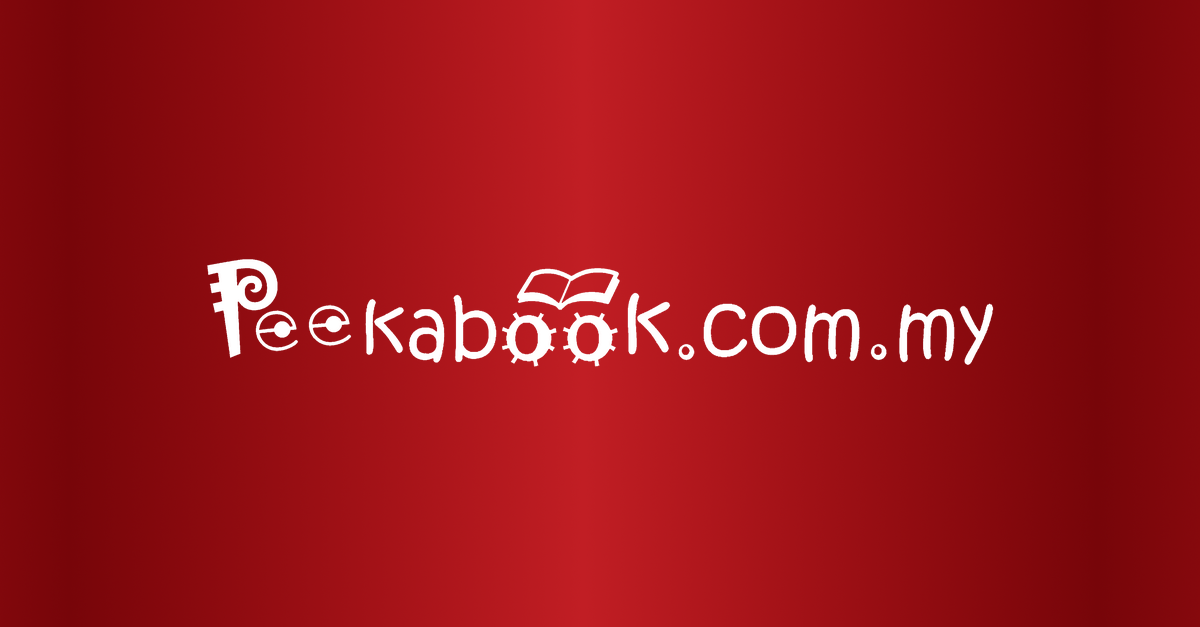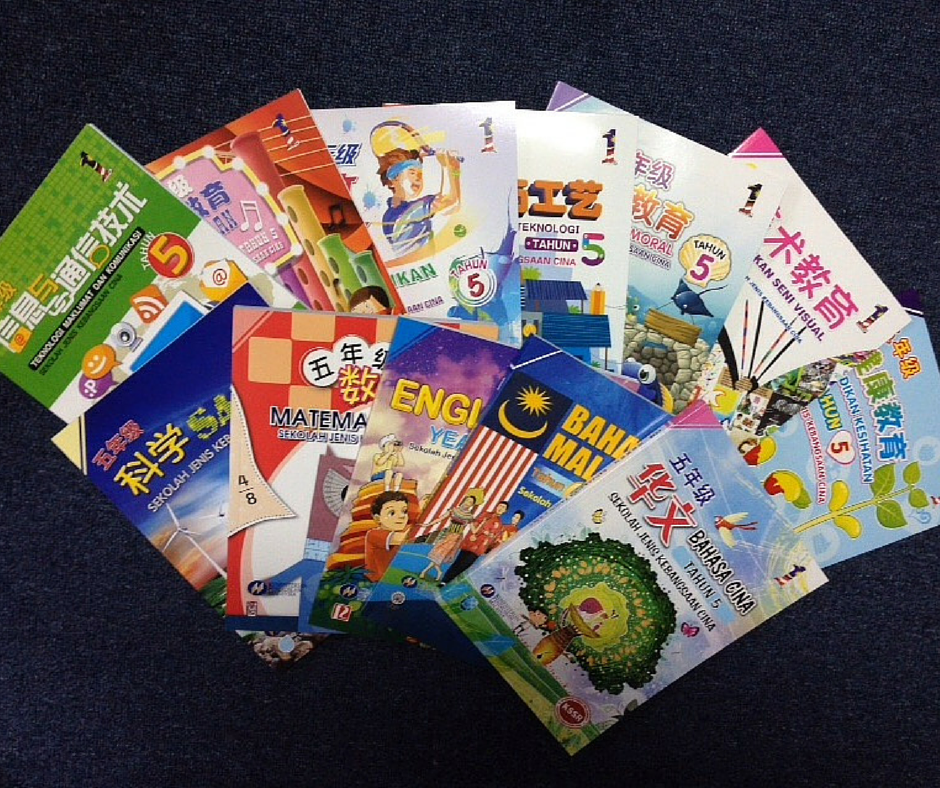Category Archives: Textbooks
Senarai Buku Teks 2015 Tahun 5 Sekolah Rendah
| JUDUL | PENERBIT | JENIS SEKOLAH |
| BAHASA MALAYSIA TAHUN 5 SK | Dewan Bahasa & Pustaka | SK |
| ENGLISH YEAR 5 SK | Dewan Bahasa & Pustaka | SK |
| BAHASA CINA SEKOLAH KEBANGSAAN TAHUN 5 | Dewan Bahasa & Pustaka | SK |
| BAHASA TAMIL SEKOLAH KEBANGSAAN TAHUN 5 | Dewan Bahasa & Pustaka | SK |
| SEJARAH TAHUN 5 SK | Dewan Bahasa & Pustaka | SK |
| PENDIDIKAN ISLAM TAHUN 5 | Dewan Bahasa & Pustaka | SK |
| SAINS TAHUN 5 SK | Dewan Bahasa & Pustaka | SK |
| PENDIDIKAN KESIHATAN TAHUN 5 SK | Dewan Bahasa & Pustaka | SK |
| MATEMATIK TAHUN 5 SK | Dewan Bahasa & Pustaka | SK |
| PENDIDIKAN MORAL TAHUN 5 SK | Dewan Bahasa & Pustaka | SK |
| PENDIDIKAN MUZIK TAHUN 5 SK | Dewan Bahasa & Pustaka | SK |
| PENDIDIKAN JASMANI TAHUN 5 SK | Dewan Bahasa & Pustaka | SK |
| REKA BENTUK DAN TEKNOLOGI TAHUN 5 SK | Dewan Bahasa & Pustaka | SK |
| TEKNOLOGI MAKLUMAT DAN KOMUNIKASI TAHUN 5 SK | Dewan Bahasa & Pustaka | SK |
| PENDIDIKAN SENI VISUAL TAHUN 5 SK | Dewan Bahasa & Pustaka | SK |
| AND SOMETHING WEIRD HAPPENED YEAR 5 | Danalis Distributors Sdn Bhd | SK |
| GULLIVER’S TRAVELS YEAR 5 | NND Enterprise | SK |
| BAHASA IBAN TAHUN 5 | Dewan Bahasa & Pustaka | SK |
| BAHASA ARAB TAHUN 5 | Dewan Bahasa & Pustaka | SK |
| BAHASA KADAZANDUSUN TAHUN 5 | Dewan Bahasa & Pustaka | SK |
| BAHASA SEMAI TAHUN 5 | Dewan Bahasa & Pustaka | SK |
| PENDIDIKAN MUZIK TAHUN 5 SK (CDROM) | Dewan Bahasa & Pustaka | SK |
| TEKNOLOGI MAKLUMAT DAN KOMUNIKASI TAHUN 5 SK (CDROM) | Dewan Bahasa & Pustaka | SK |
| BAHASA MALAYSIA TAHUN 5 SJK | Dewan Bahasa & Pustaka | SJK(C) |
| ENGLISH YEAR 5 SJK | Percetakan Rina | SJK(C) |
| BAHASA CINA TAHUN 5 SJKC | Malaya Press | SJK(C) |
| SEJARAH TAHUN 5 SJKC | Dewan Bahasa & Pustaka | SJK(C) |
| SAINS TAHUN 5 SJKC | Pan Asia | SJK(C) |
| PENDIDIKAN KESIHATAN TAHUN 5 SJKC | Heng Hui | SJK(C) |
| MATEMATIK TAHUN 5 SJKC | H&K | SJK(C) |
| PENDIDIKAN MORAL TAHUN 5 SJKC | Gemilang | SJK(C) |
| PENDIDIKAN MUZIK TAHUN 5 SJKC | Malaya Press | SJK(C) |
| PENDIDIKAN JASMANI TAHUN 5 SJKC | Malaya Press | SJK(C) |
| REKA BENTUK DAN TEKNOLOGI TAHUN 5 SJKC | Malaya Press | SJK(C) |
| TEKNOLOGI MAKLUMAT DAN KOMUNIKASI TAHUN 5 SJKC | Penerbit Bestari | SJK(C) |
| PENDIDIKAN SENI VISUAL TAHUN 5 SJKC | Proaktif Media | SJK(C) |
| PENDIDIKAN MUZIK TAHUN 5 SJKC (CDROM) | AAA | SJK(C) |
| TEKNOLOGI MAKLUMAT DAN KOMUNIKASI TAHUN 5 SJKC (CDROM) | AAA | SJK(C) |
| BAHASA MALAYSIA TAHUN 5 SJK | Dewan Bahasa & Pustaka | SJK(T) |
| ENGLISH YEAR 5 SJK | Percetakan Rina | SJK(T) |
| BAHASA TAMIL TAHUN 5 SJKT | AAA | SJK(T) |
| SEJARAH TAHUN 5 SJKT | Dewan Bahasa & Pustaka | SJK(T) |
| SAINS TAHUN 5 SJKT | AAA | SJK(T) |
| PENDIDIKAN KESIHATAN TAHUN 5 SJKT | AAA | SJK(T) |
| MATEMATIK TAHUN 5 SJKT | AAA | SJK(T) |
| PENDIDIKAN MORAL TAHUN 5 SJKT | AAA | SJK(T) |
| PENDIDIKAN MUZIK TAHUN 5 SJKT | AAA | SJK(T) |
| PENDIDIKAN JASMANI TAHUN 5 SJKT | AAA | SJK(T) |
| REKA BENTUK DAN TEKNOLOGI TAHUN 5 SJKT | AAA | SJK(T) |
| TEKNOLOGI MAKLUMAT DAN KOMUNIKASI TAHUN 5 SJKT | AAA | SJK(T) |
| PENDIDIKAN SENI VISUAL TAHUN 5 SJKT | AAA | SJK(T) |
| PENDIDIKAN MUZIK TAHUN 5 SJKT (CDROM) | AAA | SJK(T) |
| TEKNOLOGI MAKLUMAT DAN KOMUNIKASI TAHUN 5 SJKT (CDROM) | AAA | SJK(T) |
电子课本— 你怎么看?
为了让我国迈向世界级教育水平,大马教育蓝图(PPPM 2013-2025)已开始推动电子课本,并将于2021年全面落实电子课本的教育政策。由此可见,电子课本是马来西亚未来教育发展里其中最重要的一环。根据第二教育部长拿督斯里依德利斯,教育部将分三个阶段落实电子课本措施—首阶段于2013至2015 年,第二阶段于2016至2020年及第三阶段于2021至2025年。通过这个方案,它不仅确保大马能够与世界级教育水平与时并进,同时也为学生带来不少的好处,如从此把学生每天得背着沉重的书包上学的烦恼给免除。
好处一:学习更有趣、增强学生们的吸收能力
根据第二教育部长拿督斯里依德利斯,电子课本不但含有文字而已,并且有各种精美的图片、动画以帮助学生。据敦胡仙翁大学两位研究员阿莫里扎和莫哈默诺,研究证明通过动画,学习会变得更加有效、有趣。例如:在生物科里,学生更快能够掌握血液循环系统,特别是缺氧血被携带离开心脏,进入肺部进行气体交换后,将含氧血带回心脏的部分后从右心室出发传到身体每个部位。比起现有的课本,只是有着文字和少许图片,相信电子课本将会让学者们对所学习的科目更有兴趣、同时增强吸收能力。
好处二:方便、容易携带
有着电子课本,学生可随时自行在网上阅读课文、温习功课等。根据教育部,学校的课本以正在被上载到1BestariNet的网页。因此,学生可使用各自的1BestariNet ID以能够免费地阅读课本。由此可见,学生可不仅在学校范围或家里温习课文,还可轻易地在外头使用自己的手提电脑、平板电脑或智能手机等阅读课本。在此,允许我分享一些我个人的经验。身为一个还算是活跃于课外活动的我,时常无法在班上听课。每一次代表州属、学校等出外比赛时,不在学校的时间可算超多的,有时数天,有时一星期。为了避免忽略学习,我不得不携带沉重的课本到其它地方以让自己能够在空闲时温习。问题是,我该如何携带那么多课本呢?因此,有着电子课本,我相信学生能够随时随地地复习课文。
好处三:随时更新课本内容和让学生享受新的学习方法
采用电子课本可以让教育部随时随刻更新课文的知识内容。就拿美国为例子,佛州一电子公司的市场部经理马特·哥摩日认为,佛州一些学校的历史课本甚至直到现在都还没有克林顿政府的内容。比起来,电子课本可以很快地添加两周前的内容。另外,使用电子课本还可以形成新的学习方法。电子课本备有电子标签、增加亮度和颜色标记关键部分,进行重点关键词搜索。同时,大家可以随时发收电子邮件,使用网路资源查阅相关专题资源。此外,教师可以自主处理资讯以适应班级学生需求。所以,电子课本可随时加以更新及让学者们有着另一种新的学习方式。
坏处一:读者容易疲劳
综上所述,电子课本能够为大家带来数不尽的好处。但是,相信师长们一定会特别担心一个问题— 电子课本影响学生的注意力。从八十年代后期开始的一项研究结果显示,在电子课本和纸质的课本相比之下,传统书本 还是有一定的好处。《人类因素和经济社会》杂志的一项于1998年的研究显示出阅读电子课本在速度和准确性上仍不如传统书本阅读,同时让读者更容易疲劳。
坏处二:电子课本对眼睛的影响
美国儿科学研究院非常关注在孩子花费大量时间在电子屏幕时,眼科专家担心孩子的视力会消退。牛津大学神经科学家苏姗·格林菲尔德认为,社交网站、电子游戏和电视的快节奏,缩短了青少年的注意广度,从此限制他们的专注力,并可能会童稚化青少年大脑。年轻人容易被嗡嗡的声音和明亮的光线所吸引。美国埃默理大学英语教授马克·鲍林曾表示专注力和注意广度对阅读理解非常重要。电子萤幕让读者以扫描式阅读,注意力从此就会慢慢退化。同时,读者获取的资讯也就是简要的。相比之下,纸质课本却可以鼓励专注阅读。
尽管电子课本即将取代纸质课本,我相信学生仍必须依靠多做练习以在测验里获取佳绩。由于电子课本已逐渐让学生避免背着沉重的书包上课或到其它地方去时,学生可利用剩余的空间携带一些参考书,如佳辉出版社的《A无惧UPSR模拟试卷》、《A启示UPSR模拟试卷》,嘉阳出版的《复习王》作业和《配版作业》等之类的巩固练习题,以让自己更熟悉考试的问题格式并发掘自己较弱的单元,以对症下药。大家可知道,不管小学生还是中学生,熟读课本的确是不够的,各位都必须多做练习、作业才能在考试里获取优秀的成绩噢!加油!
– 黄伟铭 (Ng Ray Man)

The Malaysian Textbook Loan Scheme
The day the Government decided to implement the free textbook scheme to students was one of the better policies that has affected education in Malaysia. Free textbooks meant that students regardless of their family background and income levels were entitled to free books. Of course, the parental income was taken into consideration on who deserves the books but where I was teaching, there was more than enough for everyone.
Teachers were very much relieved that we no longer had to wait until every student had a book or that they had to share books because some of them were yet to purchase the books. Students were known to have told teachers that they had to wait until the next harvest for them to get their books, because their parents were in the agricultural sector. These seemingly funny statements were the source of great frustrations to teachers who found it difficult to conduct a proper lesson when the material was not there.
On the part of the parent, the benefit is pretty obvious. Books are expensive and when the Government provides free textbooks, parents have a huge burden removed from their shoulders. In families with five or six children, buying a textbook can create a big dent in the family’s income. With the free textbooks, the money saved could now be spent on other essentials.
As for the children, they now have textbooks in their bags. There was no longer any excuse not to focus on learning or completing the assigned homework. When students had books with them, parents could also monitor and motivate them to study. Even the poorest student had something that he/she could remove from their bag and study at home. This definitely was the best outcome of the scheme.
On the downside, the scheme has its problems. Some of the students were careless and books kept getting lost. Students were also not taking care of the books that were lent to them and it was difficult to pass on these torn books to a new set of students the following year. Schools had to have extra manpower to monitor the books. We had a set of teachers who were in charge of the Book Loan Scheme. We even had a society in school and its members were called the Book Loan Scheme Prefects and they wore purple uniforms. It was as if the school needed a brigade to keep the scheme in order. Students had to cover the books as soon as they received their sets. They also had to write their names, class and year of borrowing to keep track of the books. At the end of the year the whole process works in reverse. Students are required to check all the books that they have borrowed. Students have to buy new books to replace those that they have lost. All books need to be wrapped neatly and all writings especially doodles and answers have to be erased. Phew! What a process.
On the perspective of the teachers, there were different views in regards of the day-to-day use of the textbooks. Some used them religiously and simply loved them. Some used them sometimes, while others like me, simply hated them. I know, I sound so bad but I was one of those who always went against the grain. I felt that the textbooks tied my hands and forced me to do things I felt was not suitable for my kids. Granted, the textbooks provided an excellent guide to the syllabus and all aspects to be covered were there in the textbook. To me, it served as a guide and allowed me to complete the necessary topics but beyond that I had little use of the textbook.
My problem usually arose when I wanted to do different things with my different classes. I felt that the textbook usually hit the level of the average student and therefore was not working with all my students. My weakest class is a group of students in Form Five whose proficiency level was at the Form One or even the primary grade. What am I going to do with the textbook? My top class on the other hand had very little issues with grammar and vocabulary and were up to more challenging tasks. In fact they loved to write essays and do tasks that required high order thinking.
The textbooks were also old. Many of the comprehension texts were not the type that was of interest to the students. I was teaching in Kuala Lumpur and my students would love to read comprehension texts on the latest gadgets or mobile phones. They knew so much and have so much to say on these issues. The reading material had to be real and meaningful to them to stimulate them to use the language in a meaningful manner. I ended up using photocopied materials and workbooks to supplement the textbook. The students were hungry for more and I had to look outside for new material. As for the weak students, their language acquisition was so bad that I had to focus more on their communication skills. For them the needs of the SPM was one but the needs for survival in the outside world after SPM was another. Many told me that they were going to work after the exams and they wanted to be able to communicate in English. Their lessons were often a blend of both their needs.
So, back to the issue of the day; textbooks. For me it definitely has its merits but teachers must never get too obsessive about rigidly following it. The textbook is a guide and at the end of the day, it is the students who matter the most. Their needs must be addressed.
– Kalai Lingam

